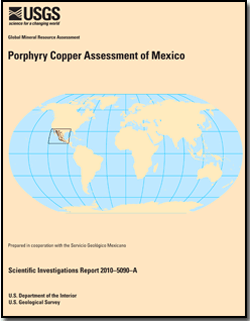Scientific Investigations Report 2010–5090–A

AbstractMineral resource assessments provide a synthesis of available information about distributions of mineral deposits in the Earth’s crust. A probabilistic mineral resource assessment of undiscovered resources in porphyry copper deposits in Mexico was done as part of a global mineral resource assessment. The purpose of the study was to (1) delineate permissive areas (tracts) for undiscovered porphyry copper deposits within 1 km of the surface at a scale of 1:1,000,000; (2) provide a database of known porphyry copper deposits and significant prospects; (3) estimate numbers of undiscovered deposits within those permissive tracts; and (4) provide probabilistic estimates of amounts of copper (Cu), molybdenum (Mo), gold (Au), and silver (Ag) that could be contained in undiscovered deposits for each permissive tract. The assessment was conducted using a three-part form of mineral resource assessment based on mineral deposit models (Singer, 1993). Delineation of permissive tracts primarily was based on distributions of mapped igneous rocks related to magmatic arcs that formed in tectonic settings associated with subduction boundary zones. Using a GIS, map units were selected from digital geologic maps based on lithology and age to delineate twelve permissive tracts associated with Jurassic, Laramide (~90 to 34 Ma), and younger Tertiary magmatic arcs. Stream-sediment geochemistry, mapped alteration, regional aeromagnetic data, and exploration history were considered in conjunction with descriptive deposit models and grade and tonnage models to guide estimates. The 12 permissive tracts delineated for this assessment are grouped by age (Jurassic-Early Cretaceous, Laramide (~90 to 34 Ma), Tertiary) and range in size from ~3,000 to 184,000 km2. Probabilistic estimates of numbers of undiscovered deposits were made for 10 tracts. A qualitative discussion is included for one Jurassic tract that extends into the U.S. from northern Mexico, and a preliminary outline of the northernmost part of a Tertiary tract that continues well to the south of Mexico is included in summary figures for reference. This assessment estimates that 39 undiscovered deposits contain an arithmetic mean estimate of ~144 million metric tons of copper or more in ten tracts for which probabilistic estimates were made, in addition to 21 porphyry copper deposits that contain identified resources of ~52 million metric tons of copper. Approximately 70 percent of the estimated mean undiscovered copper resources are associated with permissive tracts that contain identified resources; the remaining estimated resources are associated with permissive tracts with no reported porphyry copper resources. In addition to copper, the mean expected values of undiscovered byproduct resources predicted by the simulation are ~4 million metric tons of molybdenum, ~48 thousand metric tons of silver, and 4 thousand metric tons of gold. The probability associated with these arithmetic means is on the order of 30 percent. Median expected amounts of metals predicted by the simulations may be ~50 percent lower than mean estimates, and in some cases, zero. For tracts that contain identified resources, the ratios of undiscovered to identified copper resources indicate that:
Most porphyry copper exploration in Mexico focused on the exposed northern parts of the Laramide arc. This assessment suggests that the exposed and shallowly buried (<1 km) parts of the Laramide and Tertiary arcs delineated as permissive tracts are more likely to contain undiscovered deposits than are older (Jurassic-Early Cretaceous) arc segments. Interest in gold has prompted exploration of historical precious metal prospects and small mines in Mexico, some of which may represent high-sulfidation epithermal systems overlying or adjacent to porphyry copper systems. This report includes a brief overview of porphyry copper deposits in Mexico, a description of the assessment process used, a summary of results, and appendixes. Appendixes A through K contain summary information for each tract, as follows: location, the geologic feature assessed, the rationale for tract delineation, tables and descriptions of known deposits and significant prospects, exploration history, model selection, rationale for the estimates, assessment results, and references. The accompanying digital map files (shapefiles) provide permissive tract outlines, assessment results, and data for deposits and prospects in a GIS format (appendix L). |
Last modified November 1, 2010
For additional information: Part of this report is presented in Portable Document Format (PDF); the latest version of Adobe Reader or similar software is required to view it. Download the latest version of Adobe Reader, free of charge. |
Hammarstrom, J.M., Robinson, G.R., Jr., Ludington, Steve, Gray, Floyd, Drenth, B.J., Cendejas-Cruz, Francisco, Espinosa, Enrique, Pérez-Segura, Efrén, Valencia-Moreno, Martín, Rodríguez-Castañeda, José Luis, Vásquez-Mendoza, Rigoberto, and Zürcher, Lukas, 2010, Porphyry copper assessment of Mexico: U.S. Geological Survey Scientific Investigations Report 2010–5090–A, 176 p., available at http://pubs.usgs.gov/sir/2010/5090/a/.
Abstract
Introduction
Porphyry Copper Assessment of Mexico
Considerations for Users of this Assessment
Acknowledgments
References Cited
Appendixes A–L
GIS data